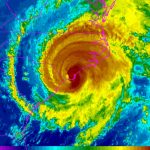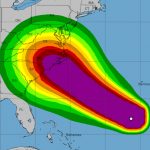
Radioactive material from Fukushima discovered in the sand and groundwater beneath the beach, releasing cesium into the ocean
Thursday, October 12, 2017 by Jhoanna Robinson
http://www.nuclear.news/2017-10-12-radioactive-material-from-fukushima-discovered-in-the-sand-and-groundwater-beneath-the-beach-releasing-cesium-into-the-ocean.html

A new study that was published on Monday, October 2 in Proceedings of the National Academy of Sciences showed that scientists were able to discover a place where radioactive material from the 2011 Fukushima Daiichi nuclear power plant mishap had gravitated to – in sands and brackish groundwater near beaches that reached up to 60 miles away.
The research team that was composed of Ken Buesseler, Matthew Charette, and Virginie Sanial of the Woods Hole Oceanographic Institution and Seiya Nagao of Kanazawa University concluded that high amounts of radioactive cesium-137 that were released into the air in 2011 were mobilized along the coasts by ocean currents.
“No one is exposed to, or drinks, these waters, and thus public health is not of primary concern here”, however, “this new and unanticipated pathway for the storage and release of radionuclides to the ocean should be taken into account in the management of coastal areas where nuclear power plants are situated,” the researchers said.
Weeks after the accident, waves brought the cesium in these highly contaminated waters onto the beach coast, where the cesium ended up becoming stuck to the sand grains’ surface. Cesium-filled sand settled on the beaches and in the brackish, slightly salty mixture of fresh water and salt water beneath the beaches.
However, in salt water, cesium no longer settled in the sand, so when more recent waves brought in salty seawater from the ocean, the brackish water underneath the beaches became salty enough to free cesium in the sand, and so cesium was carried back into the ocean.
“No one expected that the highest levels of cesium in ocean water today would be found not in the harbor of the Fukushima Daiichi nuclear power plant, but in the groundwater many miles away below the beach sands,” Sanial said.
The research team gathered sand samples from eight beaches within 60 miles of the Fukushima Daiichi nuclear power plant between 2013 and 2016 by planting three- to seven-foot long tubes into the sand, sucking underlying groundwater, and studying its cesium-137 content.
The researchers found out that the amount of cesium in the groundwater was as much as 10 times higher than the level found in seawater within the harbor of the nuclear power plant itself. The total amount of cesium that got lodged into more than three feet deep of sands is greater than what is found in sediments on the seafloor offshore of the beaches, they added.
Update on the Fukushima Daiichi trials
A district court in Fukushima made a ruling on Tuesday, October 10 that the Japanese government and Tokyo Electric (Tepco) – which is the electric utility that managed the Fukushima Daiichi nuclear power plant – should pay damages in the amount of $4.4 million to around 2,900 people. (Related: Fukushima update: TEPCO admits radiation leaks will continue for at least three more months, maybe longer.)
To date, said ruling is the largest in about 30 similar lawsuits that were filed by around 12,000 former and current Fukushima residents. The award was given even though many of the plaintiffs did not leave their place of residence after the nuclear disaster.
The nuclear meltdowns at Fukushima Daiichi, which sits on the eastern coast of Japan, happened when 32-foot tsunami waves rushed past the plant’s protective sea walls, destroying buildings and diesel-powered electric generators.
Both Tepco and the government said that the government’s own research unit was remiss in properly predicting earthquake movements, and as such is the case, further argued that they could not have possibly taken appropriate measures to guard against the flooding that transpired.
Furthermore, the government said that prior to the nuclear disaster, it did not have the regulatory authority to force Tepco to take anti-flooding protective measures, with Nuclear Regulation Authority general affairs division manager Kazohiro Okuma saying, “We understand the court did not fully acknowledge the government’s defense. We will now regulate power stations properly by applying a new regulation standard, which was created based on the nuclear accident.”
Read more stories such as this one at Radiation.news.
Sources include:





